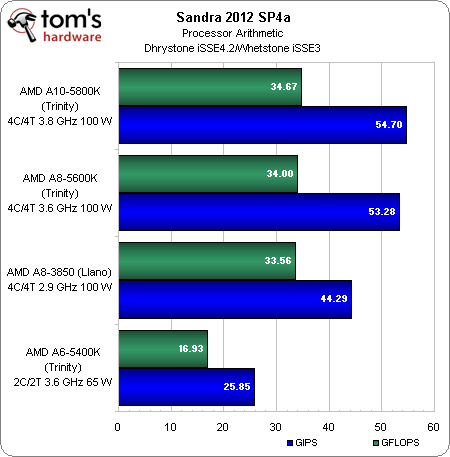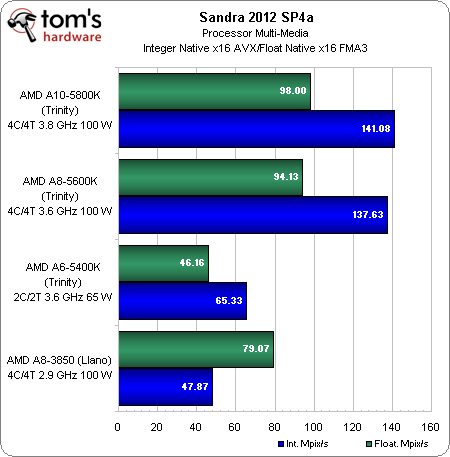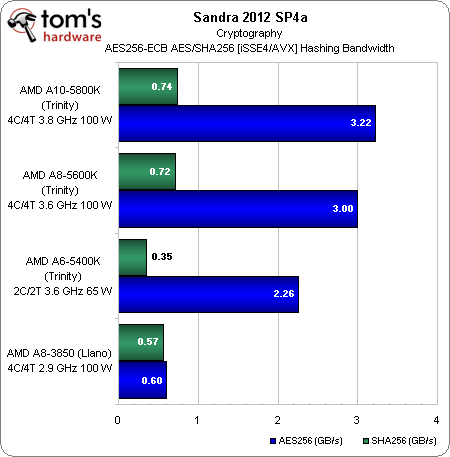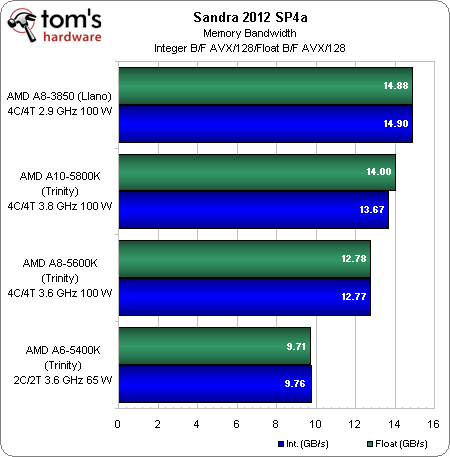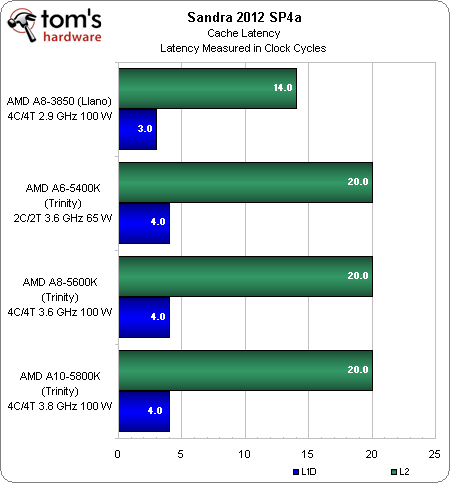AMD Trinity On The Desktop: A10, A8, And A6 Get Benchmarked!
Benchmark Results: Sandra 2012
We know that AMD isn't particularly fond of diagnostics like Sandra, which aren’t indicative of real-world alacrity. But it does help us analyze our results by exposing potential strengths and weaknesses.
Llano doesn’t have a lot of the ISA enhancements included in Trinity. However, its efficient architecture facilitates solid performance, despite a 2.9 GHz clock rate.
Support for AVX helps bolster Trinity’s floating-point performance, despite the fact that its two Piledriver modules share FP resources. The more substantial gain happens in integer throughput, which benefits from higher clock rates and four distinct cores.
Trinity includes acceleration for AES encryption and decryption, and the performance of that feature is closely tied to available memory bandwidth. Llano does not support those additional instructions, which is why it lands at the bottom of this chart for AES throughput.
Despite common data rates and timing settings, the Llano-based APU gets more out of its dual-channel DDR3 memory controller than Trinity. AMD’s newer design technically supports higher settings, though, meaning you should be able to get up to DDR3-2133 using one slot per channel.
Get Tom's Hardware's best news and in-depth reviews, straight to your inbox.
Current page: Benchmark Results: Sandra 2012
Prev Page Benchmark Results: 3DMark 11 Next Page Benchmark Results: Adobe CS5 And 6-
Youngmind This is so exciting! AMD is probably going to dominate the lower-end and give the poor gamers like me more bang-for-buck as their IGP get better and better :)!Reply -
dudewitbow depending on how its priced, its a really nice alternative for bare budget gaming that opens up a quad core as wellReply -
So this means that a 'Crossfired' Trinity APU would beat ANY similarly-priced Intel (CPU+discrete GPU) ???Reply
Well at least in gaming -
dudewitbow JiggerByteSo this means that a 'Crossfired' Trinity APU would beat ANY similarly-priced Intel (CPU+discrete GPU) ???Well at least in gamingReply
really the question is what gpus are able to hybrid crossfire with it. the information was never public. not all amd gpus will hybrid crossfire with it. -
Well, where are the Ivy/Sandy i5's and i3's???Reply
Once they are pitted against each other, that will be A TRUE measure of the APU Trinity's marketability -
mayankleoboy1 in the OpenCL Winzip benchmark, when openCL is enabled the workload is done only by the iGPU or the CPU as well ?Reply
i mean what is the processor usage during the benchmark ? are all CPU cores used? or only one? -
cangelini mayankleoboy1in the OpenCL Winzip benchmark, when openCL is enabled the workload is done only by the iGPU or the CPU as well ?i mean what is the processor usage during the benchmark ? are all CPU cores used? or only one?Good question--I'll take a look for you.Reply
